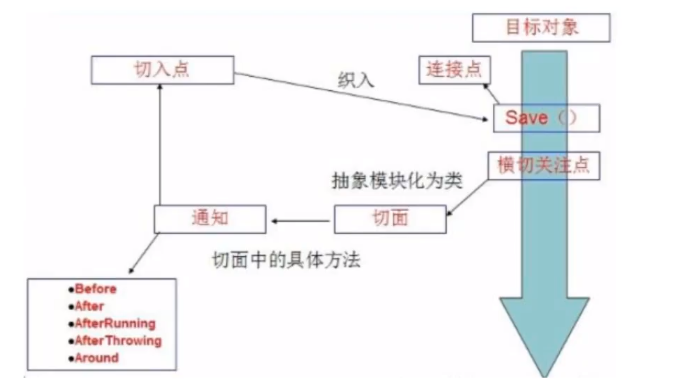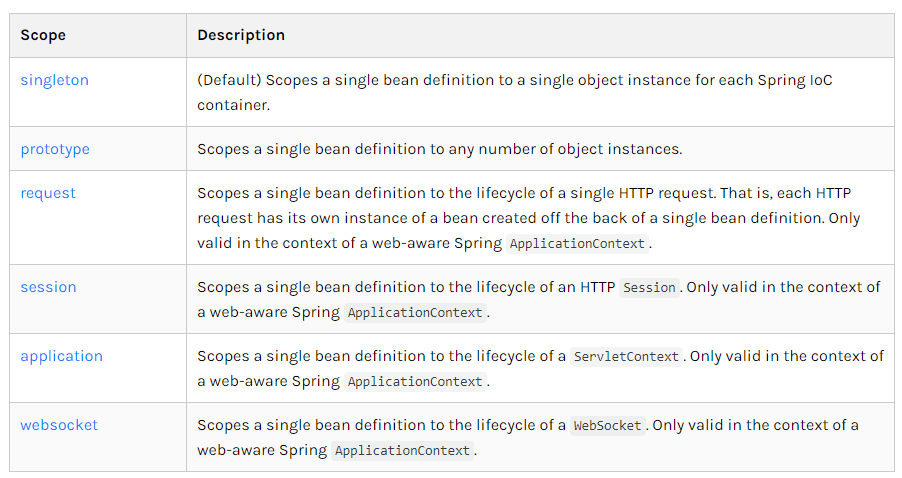搜索到
5
篇与
的结果
-
 AOP AOPAOP(Aspect Oriented Programing),面向切面编程,通过预编译方式和运行期动态代理实现程序功能的统一维护的一种技术。AOP是OOP的延续,利用AOP可以对业务逻辑的各个部分进行隔离,从而使业务逻辑各部分之间的耦合降低,提高程序的可重用性。1、Aop在Spring中的作用==提供声明式事务;允许用户自定义切面==横切关注点:跨越应用程序多个模块的方法或功能,即:与业务逻辑无关,但需要关注的部分就是横切关注点,如:日志、缓存、事务等切面(Aspect):横切关注点被模块化的都特殊对象,具体为一个类通知(Advice):切面必须要完成的工作,类中的一个方法目标(Target):被通知对象代理(Proxy):向目标对象应用通知之后创建的对象切入点(PointCut):需要执行切面通知的”地点“连接点(JoinPoint):与切入点匹配的执行点在SpringAop中,通过Advice定义横切逻辑,Spring中支持5中类型的Advice:通知类型连接点实现接口前置通知方法前org.springframework.aop.MethodBeforeAdvice后置通知方法后org.springframework.aop.AfterReturningAdvice环绕通知方法前后org.springframework.aop.MethodInterceptor异常抛出通知方法抛出异常org.springframework.aop.ThrowsAdvice引介通知类中增加新的方法属性org.springframework.aop.IntroductionInterceptor2、使用Spring实现AOP在pom.xml中导入依赖<dependencies> <dependency> <groupId>org.aspectj</groupId> <artifactId>aspectjweaver</artifactId> <version>1.9.4</version> </dependency> </dependencies>3、使用Spring实现Aop方式一:使用Spring的API接口方式二:自定义实现AOP【定义切面】方式三:使用注解<?xml version="1.0" encoding="UTF-8"?> <beans xmlns="http://www.springframework.org/schema/beans" xmlns:xsi="http://www.w3.org/2001/XMLSchema-instance" xmlns:aop="http://www.springframework.org/schema/aop" xsi:schemaLocation="http://www.springframework.org/schema/beans https://www.springframework.org/schema/beans/spring-beans.xsd http://www.springframework.org/schema/aop https://www.springframework.org/schema/aop/spring-aop.xsd"> <!--注册bean--> <bean id="userService" class="com.sw.service.UserServiceImpl"/> <bean id="log" class="com.sw.log.Log"/> <bean id="afterLog" class="com.sw.log.AfterLog"/> <!--方式一:使用原生Spring API配置--> <!--配置aop:需导入AOP约束--> <aop:config> <!--切入点:execution(要执行的位置)--> <aop:pointcut id="pointcut" expression="execution(* com.sw.service.UserServiceImpl.*(..))"/> <!--执行环绕增强--> <aop:advisor advice-ref="log" pointcut-ref="pointcut"/> <aop:advisor advice-ref="afterLog" pointcut-ref="pointcut"/> </aop:config> <!--方式二:自定义--> <bean id="diy" class="com.sw.diy.DiyLog"/> <aop:config> <!--自定义切面,ref:要引用的类--> <aop:aspect ref="diy"> <!--切入点--> <aop:pointcut id="pointcut" expression="execution(* com.sw.service.UserServiceImpl.*(..))"/> <!--通知--> <aop:before method="before" pointcut-ref="pointcut"/> <aop:after method="after" pointcut-ref="pointcut"/> </aop:aspect> </aop:config> <!--方式三:通过注解--> <bean id="annotationPointCut" class="com.sw.diy.AnnotationPointCut"/> <!--开启注解 JDK:expose-proxy="false"(默认) cglib:expose-proxy="true" --> <aop:aspectj-autoproxy /> </beans>
AOP AOPAOP(Aspect Oriented Programing),面向切面编程,通过预编译方式和运行期动态代理实现程序功能的统一维护的一种技术。AOP是OOP的延续,利用AOP可以对业务逻辑的各个部分进行隔离,从而使业务逻辑各部分之间的耦合降低,提高程序的可重用性。1、Aop在Spring中的作用==提供声明式事务;允许用户自定义切面==横切关注点:跨越应用程序多个模块的方法或功能,即:与业务逻辑无关,但需要关注的部分就是横切关注点,如:日志、缓存、事务等切面(Aspect):横切关注点被模块化的都特殊对象,具体为一个类通知(Advice):切面必须要完成的工作,类中的一个方法目标(Target):被通知对象代理(Proxy):向目标对象应用通知之后创建的对象切入点(PointCut):需要执行切面通知的”地点“连接点(JoinPoint):与切入点匹配的执行点在SpringAop中,通过Advice定义横切逻辑,Spring中支持5中类型的Advice:通知类型连接点实现接口前置通知方法前org.springframework.aop.MethodBeforeAdvice后置通知方法后org.springframework.aop.AfterReturningAdvice环绕通知方法前后org.springframework.aop.MethodInterceptor异常抛出通知方法抛出异常org.springframework.aop.ThrowsAdvice引介通知类中增加新的方法属性org.springframework.aop.IntroductionInterceptor2、使用Spring实现AOP在pom.xml中导入依赖<dependencies> <dependency> <groupId>org.aspectj</groupId> <artifactId>aspectjweaver</artifactId> <version>1.9.4</version> </dependency> </dependencies>3、使用Spring实现Aop方式一:使用Spring的API接口方式二:自定义实现AOP【定义切面】方式三:使用注解<?xml version="1.0" encoding="UTF-8"?> <beans xmlns="http://www.springframework.org/schema/beans" xmlns:xsi="http://www.w3.org/2001/XMLSchema-instance" xmlns:aop="http://www.springframework.org/schema/aop" xsi:schemaLocation="http://www.springframework.org/schema/beans https://www.springframework.org/schema/beans/spring-beans.xsd http://www.springframework.org/schema/aop https://www.springframework.org/schema/aop/spring-aop.xsd"> <!--注册bean--> <bean id="userService" class="com.sw.service.UserServiceImpl"/> <bean id="log" class="com.sw.log.Log"/> <bean id="afterLog" class="com.sw.log.AfterLog"/> <!--方式一:使用原生Spring API配置--> <!--配置aop:需导入AOP约束--> <aop:config> <!--切入点:execution(要执行的位置)--> <aop:pointcut id="pointcut" expression="execution(* com.sw.service.UserServiceImpl.*(..))"/> <!--执行环绕增强--> <aop:advisor advice-ref="log" pointcut-ref="pointcut"/> <aop:advisor advice-ref="afterLog" pointcut-ref="pointcut"/> </aop:config> <!--方式二:自定义--> <bean id="diy" class="com.sw.diy.DiyLog"/> <aop:config> <!--自定义切面,ref:要引用的类--> <aop:aspect ref="diy"> <!--切入点--> <aop:pointcut id="pointcut" expression="execution(* com.sw.service.UserServiceImpl.*(..))"/> <!--通知--> <aop:before method="before" pointcut-ref="pointcut"/> <aop:after method="after" pointcut-ref="pointcut"/> </aop:aspect> </aop:config> <!--方式三:通过注解--> <bean id="annotationPointCut" class="com.sw.diy.AnnotationPointCut"/> <!--开启注解 JDK:expose-proxy="false"(默认) cglib:expose-proxy="true" --> <aop:aspectj-autoproxy /> </beans> -
 代理模式 代理模式代理模式的分类:静态代理动态代理自己 --- > 租房中介 --- > 房东1、静态代理角色分析:抽象角色:一般使用抽象类或接口真实角色:被代理的角色代理角色:代理真实角色,同时可以做一些附属操作客户:访问代理对象的人租房Demo:1、接口package com.sw.demo01; /** * @Author suaxi * @Date 2020/12/16 10:06 */ //租房 public interface Rent { public void rent(); } 2、真实角色package com.sw.demo01; /** * @Author suaxi * @Date 2020/12/16 10:08 */ //房东 public class Host implements Rent{ public void rent() { System.out.println("房东要出租房子"); } } 3、代理角色package com.sw.demo01; /** * @Author suaxi * @Date 2020/12/16 10:10 */ public class Proxy { private Host host; public Proxy() { } public Proxy(Host host) { this.host = host; } public void rent(){ seeHouse(); host.rent(); hetong(); getFee(); } //看房 public void seeHouse(){ System.out.println("中介带租客看房!"); } //签合同 public void hetong(){ System.out.println("签租赁合同"); } //收中介费 public void getFee(){ System.out.println("中介收取中介费用!"); } } 4、客户端访问代理角色package com.sw.demo01; /** * @Author suaxi * @Date 2020/12/16 10:09 */ public class Client { public static void main(String[] args) { //房东想要出租房子 Host host = new Host(); //通过中介帮房东代理发布出租信息,同时中介角色带有一些附属操作 Proxy proxy = new Proxy(host); //客户不用面对房东,直接找中介即可 proxy.rent(); } } 静态代理的优点:可以使真实角色(房东)的操作更加纯粹,即只做租房一件事,不用去关注其他的公共事务公共事务交给代理角色(中介),实现业务分工公共业务需要拓展的时候,方便集中管理缺点:一个真实角色就需要对应的一个代理角色,开发效率低。2、动态代理动态代理与静态代理的角色一样代理类是动态生成的分为两类:基于接口的动态代理,基于类的动态代理基于接口:JDK动态代理基于类:cglibJava字节码实现:javasist动态代理的优点:可以使真实角色的操作更加纯粹,不用去关注其他的公共事务公共事务交给代理角色,实现业务分工公共业务需要拓展的时候,方便集中管理一个动态代理类代理的是一个接口,即对应一类业务一个动态代理可以代理多个类,只要实现同一个接口即可1、接口package com.sw.demo04; /** * @Author suaxi * @Date 2020/12/16 11:00 */ public interface UserService { public void add(); public void delete(); public void find(); public void update(); } 2、真实角色package com.sw.demo04; /** * @Author suaxi * @Date 2020/12/16 11:01 */ public class UserServiceImpl implements UserService{ public void add() { System.out.println("新增了一个用户"); } public void delete() { System.out.println("删除了一个用户"); } public void find() { System.out.println("查询用户"); } public void update() { System.out.println("修改用户信息"); } } 3、ProxyInvocationHandlerpackage com.sw.demo04; import java.lang.reflect.InvocationHandler; import java.lang.reflect.Method; import java.lang.reflect.Proxy; /** * @Author suaxi * @Date 2020/12/16 10:39 */ public class ProxyInvocationHandler implements InvocationHandler { //被代理的接口 private Object target; public void setTarget(Object target) { this.target = target; } //生成代理对象 public Object getProxy(){ return Proxy.newProxyInstance(this.getClass().getClassLoader(),target.getClass().getInterfaces(),this); } //处理代理实例,并返回结果 public Object invoke(Object proxy, Method method, Object[] args) throws Throwable { log(method.getName()); Object result = method.invoke(target, args); return result; } public void log(String msg){ System.out.println("执行了"+msg+"方法!"); } } 4、具体实现package com.sw.demo04; /** * @Author suaxi * @Date 2020/12/16 10:57 */ public class Client { public static void main(String[] args) { //真实角色 UserServiceImpl userService = new UserServiceImpl(); //代理角色(不存在) ProxyInvocationHandler pih = new ProxyInvocationHandler(); pih.setTarget(userService); //设置要代理的对象 //动态生成代理类 UserService proxy = (UserService) pih.getProxy(); proxy.add(); } } 代理多个类时,只要实现同一个UserService接口即可UserServiceImpl01 userService = new UserServiceImpl01(); UserServiceImpl02 userService = new UserServiceImpl02(); ……
代理模式 代理模式代理模式的分类:静态代理动态代理自己 --- > 租房中介 --- > 房东1、静态代理角色分析:抽象角色:一般使用抽象类或接口真实角色:被代理的角色代理角色:代理真实角色,同时可以做一些附属操作客户:访问代理对象的人租房Demo:1、接口package com.sw.demo01; /** * @Author suaxi * @Date 2020/12/16 10:06 */ //租房 public interface Rent { public void rent(); } 2、真实角色package com.sw.demo01; /** * @Author suaxi * @Date 2020/12/16 10:08 */ //房东 public class Host implements Rent{ public void rent() { System.out.println("房东要出租房子"); } } 3、代理角色package com.sw.demo01; /** * @Author suaxi * @Date 2020/12/16 10:10 */ public class Proxy { private Host host; public Proxy() { } public Proxy(Host host) { this.host = host; } public void rent(){ seeHouse(); host.rent(); hetong(); getFee(); } //看房 public void seeHouse(){ System.out.println("中介带租客看房!"); } //签合同 public void hetong(){ System.out.println("签租赁合同"); } //收中介费 public void getFee(){ System.out.println("中介收取中介费用!"); } } 4、客户端访问代理角色package com.sw.demo01; /** * @Author suaxi * @Date 2020/12/16 10:09 */ public class Client { public static void main(String[] args) { //房东想要出租房子 Host host = new Host(); //通过中介帮房东代理发布出租信息,同时中介角色带有一些附属操作 Proxy proxy = new Proxy(host); //客户不用面对房东,直接找中介即可 proxy.rent(); } } 静态代理的优点:可以使真实角色(房东)的操作更加纯粹,即只做租房一件事,不用去关注其他的公共事务公共事务交给代理角色(中介),实现业务分工公共业务需要拓展的时候,方便集中管理缺点:一个真实角色就需要对应的一个代理角色,开发效率低。2、动态代理动态代理与静态代理的角色一样代理类是动态生成的分为两类:基于接口的动态代理,基于类的动态代理基于接口:JDK动态代理基于类:cglibJava字节码实现:javasist动态代理的优点:可以使真实角色的操作更加纯粹,不用去关注其他的公共事务公共事务交给代理角色,实现业务分工公共业务需要拓展的时候,方便集中管理一个动态代理类代理的是一个接口,即对应一类业务一个动态代理可以代理多个类,只要实现同一个接口即可1、接口package com.sw.demo04; /** * @Author suaxi * @Date 2020/12/16 11:00 */ public interface UserService { public void add(); public void delete(); public void find(); public void update(); } 2、真实角色package com.sw.demo04; /** * @Author suaxi * @Date 2020/12/16 11:01 */ public class UserServiceImpl implements UserService{ public void add() { System.out.println("新增了一个用户"); } public void delete() { System.out.println("删除了一个用户"); } public void find() { System.out.println("查询用户"); } public void update() { System.out.println("修改用户信息"); } } 3、ProxyInvocationHandlerpackage com.sw.demo04; import java.lang.reflect.InvocationHandler; import java.lang.reflect.Method; import java.lang.reflect.Proxy; /** * @Author suaxi * @Date 2020/12/16 10:39 */ public class ProxyInvocationHandler implements InvocationHandler { //被代理的接口 private Object target; public void setTarget(Object target) { this.target = target; } //生成代理对象 public Object getProxy(){ return Proxy.newProxyInstance(this.getClass().getClassLoader(),target.getClass().getInterfaces(),this); } //处理代理实例,并返回结果 public Object invoke(Object proxy, Method method, Object[] args) throws Throwable { log(method.getName()); Object result = method.invoke(target, args); return result; } public void log(String msg){ System.out.println("执行了"+msg+"方法!"); } } 4、具体实现package com.sw.demo04; /** * @Author suaxi * @Date 2020/12/16 10:57 */ public class Client { public static void main(String[] args) { //真实角色 UserServiceImpl userService = new UserServiceImpl(); //代理角色(不存在) ProxyInvocationHandler pih = new ProxyInvocationHandler(); pih.setTarget(userService); //设置要代理的对象 //动态生成代理类 UserService proxy = (UserService) pih.getProxy(); proxy.add(); } } 代理多个类时,只要实现同一个UserService接口即可UserServiceImpl01 userService = new UserServiceImpl01(); UserServiceImpl02 userService = new UserServiceImpl02(); …… -
 Bean的自动装配 Bean的自动装配==Spring会在上下文中自动寻找,并自动给bean装配属性==三种方式:1、在xml中显示的配置2、在Java中显示配置3、隐式的自动装配bean1、测试环境搭建:一个人有两个宠物Demo2、byName自动装配<bean id="cat" class="com.sw.pojo.Cat"/> <bean id="dog" class="com.sw.pojo.Dog"/> <!--byName:会自动在容器上下文中查找和自己对象中(Person)set方法后面的值对应的beanid--> <bean id="person" class="com.sw.pojo.Person" autowire="byName"> <property name="name" value="孙笑川"/> </bean>3、byType自动装配<bean id="cat2" class="com.sw.pojo.Cat"/> <bean id="dog1" class="com.sw.pojo.Dog"/> <!-- byName:会自动在容器上下文中查找,和自己对象中(Person)set方法后面的值对应的beanid byType:会自动在容器上下文中查找,和自己对象属性类型相对应的bean --> <bean id="person" class="com.sw.pojo.Person" autowire="byType"> <property name="name" value="孙笑川"/> </bean>注:byName:需要保证所有bean的id唯一,且这个bean需要和自动注入的属性的set方法的值一致byType:需要保证所有bean的class唯一,且这个bean需要和自动注入的属性的类型一致4、使用注解实现自动装配1、导入context约束2、开启注解<?xml version="1.0" encoding="UTF-8"?> <beans xmlns="http://www.springframework.org/schema/beans" xmlns:xsi="http://www.w3.org/2001/XMLSchema-instance" xmlns:context="http://www.springframework.org/schema/context" xsi:schemaLocation="http://www.springframework.org/schema/beans https://www.springframework.org/schema/beans/spring-beans.xsd http://www.springframework.org/schema/context https://www.springframework.org/schema/context/spring-context.xsd"> <context:annotation-config/> </beans>@Autowired 直接在属性上用即可,也可以在set方法上使用@Nullable //字段标记了这个注解,说明这个字段可以为null@Autowired(required = false) //如果显示的定义Autowired的required属性为fasle,说明这个对象可以为空//默认为true 不允许为空 public @interface Autowired { boolean required() default true; }注:如果@Autowired自动装配的环境比较复杂,无法通过一个@Autowired注解完成的时候,可以使用@Qualifier(value = "xxx"),指定一个唯一的bean对象public class Person { private String name; @Autowired private Dog dog; @Autowired @Qualifier(value = "cat") private Cat cat; }@Resourcepublic class Person { private String name; @Resource(name = "cat1212") private Dog dog; @Resource private Cat cat; }小结:@Autowired与@Resource的区别都是用来自动装配的@Autowired 通过byType的方式实现,且对象必须存在@Resource 默认通过byName的方式实现,如果找不到对应的bean id,则通过byType实现
Bean的自动装配 Bean的自动装配==Spring会在上下文中自动寻找,并自动给bean装配属性==三种方式:1、在xml中显示的配置2、在Java中显示配置3、隐式的自动装配bean1、测试环境搭建:一个人有两个宠物Demo2、byName自动装配<bean id="cat" class="com.sw.pojo.Cat"/> <bean id="dog" class="com.sw.pojo.Dog"/> <!--byName:会自动在容器上下文中查找和自己对象中(Person)set方法后面的值对应的beanid--> <bean id="person" class="com.sw.pojo.Person" autowire="byName"> <property name="name" value="孙笑川"/> </bean>3、byType自动装配<bean id="cat2" class="com.sw.pojo.Cat"/> <bean id="dog1" class="com.sw.pojo.Dog"/> <!-- byName:会自动在容器上下文中查找,和自己对象中(Person)set方法后面的值对应的beanid byType:会自动在容器上下文中查找,和自己对象属性类型相对应的bean --> <bean id="person" class="com.sw.pojo.Person" autowire="byType"> <property name="name" value="孙笑川"/> </bean>注:byName:需要保证所有bean的id唯一,且这个bean需要和自动注入的属性的set方法的值一致byType:需要保证所有bean的class唯一,且这个bean需要和自动注入的属性的类型一致4、使用注解实现自动装配1、导入context约束2、开启注解<?xml version="1.0" encoding="UTF-8"?> <beans xmlns="http://www.springframework.org/schema/beans" xmlns:xsi="http://www.w3.org/2001/XMLSchema-instance" xmlns:context="http://www.springframework.org/schema/context" xsi:schemaLocation="http://www.springframework.org/schema/beans https://www.springframework.org/schema/beans/spring-beans.xsd http://www.springframework.org/schema/context https://www.springframework.org/schema/context/spring-context.xsd"> <context:annotation-config/> </beans>@Autowired 直接在属性上用即可,也可以在set方法上使用@Nullable //字段标记了这个注解,说明这个字段可以为null@Autowired(required = false) //如果显示的定义Autowired的required属性为fasle,说明这个对象可以为空//默认为true 不允许为空 public @interface Autowired { boolean required() default true; }注:如果@Autowired自动装配的环境比较复杂,无法通过一个@Autowired注解完成的时候,可以使用@Qualifier(value = "xxx"),指定一个唯一的bean对象public class Person { private String name; @Autowired private Dog dog; @Autowired @Qualifier(value = "cat") private Cat cat; }@Resourcepublic class Person { private String name; @Resource(name = "cat1212") private Dog dog; @Resource private Cat cat; }小结:@Autowired与@Resource的区别都是用来自动装配的@Autowired 通过byType的方式实现,且对象必须存在@Resource 默认通过byName的方式实现,如果找不到对应的bean id,则通过byType实现 -
 依赖注入 依赖注入1、构造器注入参考IoC创建对象的方式2、Set方式注入依赖注入:Set注入依赖:bean对象的创建依赖于容器注入:bean对象中的所有属性,由容器来注入环境搭建:1、复杂类型package com.sw.pojo; /** * @Author suaxi * @Date 2020/12/14 16:32 */ public class Adress { private String adress; public String getAdress() { return adress; } public void setAdress(String adress) { this.adress = adress; } } 2、真实测试对象package com.sw.pojo; import java.util.*; /** * @Author suaxi * @Date 2020/12/14 16:32 */ public class Student { private String name; private Adress adress; private String[] books; private List<String> hobbys; private Map<String,String> card; private Set<String> games; private String wife; private Properties info; …… } 3、beans.xml<?xml version="1.0" encoding="UTF-8"?> <beans xmlns="http://www.springframework.org/schema/beans" xmlns:xsi="http://www.w3.org/2001/XMLSchema-instance" xsi:schemaLocation="http://www.springframework.org/schema/beans https://www.springframework.org/schema/beans/spring-beans.xsd"> <bean id="student" class="com.sw.pojo.Student"> <!--普通值注入 value--> <property name="name" value="孙笑川"/> </bean> </beans>4、测试类import com.sw.pojo.Student; import org.springframework.context.ApplicationContext; import org.springframework.context.support.ClassPathXmlApplicationContext; /** * @Author suaxi * @Date 2020/12/14 16:38 */ public class MyTest { public static void main(String[] args) { ApplicationContext context = new ClassPathXmlApplicationContext("beans.xml"); Student student = (Student) context.getBean("student"); System.out.println(student.getName()); } } beans.xml补充:<?xml version="1.0" encoding="UTF-8"?> <beans xmlns="http://www.springframework.org/schema/beans" xmlns:xsi="http://www.w3.org/2001/XMLSchema-instance" xsi:schemaLocation="http://www.springframework.org/schema/beans https://www.springframework.org/schema/beans/spring-beans.xsd"> <bean id="address" class="com.sw.pojo.Address"> <property name="address" value="昆明"/> </bean> <bean id="student" class="com.sw.pojo.Student"> <!--普通值注入 value--> <property name="name" value="孙笑川"/> <!--bean注入 ref--> <property name="address" ref="address"/> <!--数组--> <property name="books"> <array> <value>高数一</value> <value>英语一</value> <value>毛概</value> </array> </property> <!--list--> <property name="hobbys"> <list> <value>跑步</value> <value>游泳</value> <value>听音乐</value> </list> </property> <!--map--> <property name="card"> <map> <entry key="身份证" value="12345678"/> <entry key="银行卡" value="87654321"/> </map> </property> <!--set--> <property name="games"> <set> <value>LOL</value> <value>FF14</value> <value>CSGO</value> </set> </property> <!--null--> <property name="wife"> <null/> </property> <!--properties--> <property name="info"> <props> <prop key="姓名">孙笑川</prop> <prop key="学号">123</prop> <prop key="性别">男</prop> </props> </property> </bean> </beans>3、拓展方式注入可以使用p命名空间和c命名空间<?xml version="1.0" encoding="UTF-8"?> <beans xmlns="http://www.springframework.org/schema/beans" xmlns:xsi="http://www.w3.org/2001/XMLSchema-instance" xmlns:p="http://www.springframework.org/schema/p" xmlns:c="http://www.springframework.org/schema/c" xsi:schemaLocation="http://www.springframework.org/schema/beans https://www.springframework.org/schema/beans/spring-beans.xsd"> <!--p命名空间注入,可以直接注入属性的值:property--> <bean id="user" class="com.sw.pojo.User" p:id="1" p:name="孙笑川"/> <!--c命名空间注入,通过构造器注入constructor-args--> <bean id="user1" class="com.sw.pojo.User" c:id="2" c:name="刘波"/> </beans>注:使用前需导入xml约束xmlns:p="http://www.springframework.org/schema/p" xmlns:c="http://www.springframework.org/schema/c"4、bean的作用域1、单例模式(Spring默认)<bean id="user1" class="com.sw.pojo.User" c:id="2" c:name="刘波" scope="singleton"/>@Test public void test1(){ ApplicationContext context = new ClassPathXmlApplicationContext("userBeans.xml"); User user1 = (User) context.getBean("user"); User user2 = (User) context.getBean("user"); System.out.println(user1==user2); //true }2、原型模式:每次从容器中get的时候都会产生一个新对象<bean id="user1" class="com.sw.pojo.User" c:id="2" c:name="刘波" scope="prototype"/>@Test public void test1(){ ApplicationContext context = new ClassPathXmlApplicationContext("userBeans.xml"); User user1 = (User) context.getBean("user1"); User user2 = (User) context.getBean("user1"); System.out.println(user1.hashCode()); //838411509 System.out.println(user2.hashCode()); //1434041222 System.out.println(user1==user2); //false }3、其余的request、session、application在web开发中使用
依赖注入 依赖注入1、构造器注入参考IoC创建对象的方式2、Set方式注入依赖注入:Set注入依赖:bean对象的创建依赖于容器注入:bean对象中的所有属性,由容器来注入环境搭建:1、复杂类型package com.sw.pojo; /** * @Author suaxi * @Date 2020/12/14 16:32 */ public class Adress { private String adress; public String getAdress() { return adress; } public void setAdress(String adress) { this.adress = adress; } } 2、真实测试对象package com.sw.pojo; import java.util.*; /** * @Author suaxi * @Date 2020/12/14 16:32 */ public class Student { private String name; private Adress adress; private String[] books; private List<String> hobbys; private Map<String,String> card; private Set<String> games; private String wife; private Properties info; …… } 3、beans.xml<?xml version="1.0" encoding="UTF-8"?> <beans xmlns="http://www.springframework.org/schema/beans" xmlns:xsi="http://www.w3.org/2001/XMLSchema-instance" xsi:schemaLocation="http://www.springframework.org/schema/beans https://www.springframework.org/schema/beans/spring-beans.xsd"> <bean id="student" class="com.sw.pojo.Student"> <!--普通值注入 value--> <property name="name" value="孙笑川"/> </bean> </beans>4、测试类import com.sw.pojo.Student; import org.springframework.context.ApplicationContext; import org.springframework.context.support.ClassPathXmlApplicationContext; /** * @Author suaxi * @Date 2020/12/14 16:38 */ public class MyTest { public static void main(String[] args) { ApplicationContext context = new ClassPathXmlApplicationContext("beans.xml"); Student student = (Student) context.getBean("student"); System.out.println(student.getName()); } } beans.xml补充:<?xml version="1.0" encoding="UTF-8"?> <beans xmlns="http://www.springframework.org/schema/beans" xmlns:xsi="http://www.w3.org/2001/XMLSchema-instance" xsi:schemaLocation="http://www.springframework.org/schema/beans https://www.springframework.org/schema/beans/spring-beans.xsd"> <bean id="address" class="com.sw.pojo.Address"> <property name="address" value="昆明"/> </bean> <bean id="student" class="com.sw.pojo.Student"> <!--普通值注入 value--> <property name="name" value="孙笑川"/> <!--bean注入 ref--> <property name="address" ref="address"/> <!--数组--> <property name="books"> <array> <value>高数一</value> <value>英语一</value> <value>毛概</value> </array> </property> <!--list--> <property name="hobbys"> <list> <value>跑步</value> <value>游泳</value> <value>听音乐</value> </list> </property> <!--map--> <property name="card"> <map> <entry key="身份证" value="12345678"/> <entry key="银行卡" value="87654321"/> </map> </property> <!--set--> <property name="games"> <set> <value>LOL</value> <value>FF14</value> <value>CSGO</value> </set> </property> <!--null--> <property name="wife"> <null/> </property> <!--properties--> <property name="info"> <props> <prop key="姓名">孙笑川</prop> <prop key="学号">123</prop> <prop key="性别">男</prop> </props> </property> </bean> </beans>3、拓展方式注入可以使用p命名空间和c命名空间<?xml version="1.0" encoding="UTF-8"?> <beans xmlns="http://www.springframework.org/schema/beans" xmlns:xsi="http://www.w3.org/2001/XMLSchema-instance" xmlns:p="http://www.springframework.org/schema/p" xmlns:c="http://www.springframework.org/schema/c" xsi:schemaLocation="http://www.springframework.org/schema/beans https://www.springframework.org/schema/beans/spring-beans.xsd"> <!--p命名空间注入,可以直接注入属性的值:property--> <bean id="user" class="com.sw.pojo.User" p:id="1" p:name="孙笑川"/> <!--c命名空间注入,通过构造器注入constructor-args--> <bean id="user1" class="com.sw.pojo.User" c:id="2" c:name="刘波"/> </beans>注:使用前需导入xml约束xmlns:p="http://www.springframework.org/schema/p" xmlns:c="http://www.springframework.org/schema/c"4、bean的作用域1、单例模式(Spring默认)<bean id="user1" class="com.sw.pojo.User" c:id="2" c:name="刘波" scope="singleton"/>@Test public void test1(){ ApplicationContext context = new ClassPathXmlApplicationContext("userBeans.xml"); User user1 = (User) context.getBean("user"); User user2 = (User) context.getBean("user"); System.out.println(user1==user2); //true }2、原型模式:每次从容器中get的时候都会产生一个新对象<bean id="user1" class="com.sw.pojo.User" c:id="2" c:name="刘波" scope="prototype"/>@Test public void test1(){ ApplicationContext context = new ClassPathXmlApplicationContext("userBeans.xml"); User user1 = (User) context.getBean("user1"); User user2 = (User) context.getBean("user1"); System.out.println(user1.hashCode()); //838411509 System.out.println(user2.hashCode()); //1434041222 System.out.println(user1==user2); //false }3、其余的request、session、application在web开发中使用 -
 Spring配置(applicationContext.xml) Spring配置1、别名<!--别名--> <alias name="user" alias="newUser"/>2、Bean配置<!-- id:bean的唯一标识符(相当于对象名) class:bean对象所对应的全限定类名,格式:包名 + 类型 name:别名,可以同时取多个(alias只能一对一) --> <bean id="user2" class="com.sw.pojo.User2" name="a,b c;d"> <property name="name" value="test"/> </bean>3、import可以将多个配置文件导入合并为一个例:一个项目由多个人负责开发,每个人负责的类不相同,且不同的类需要注册在不同的bean中,则可以利用import将所有人的beans.xml合并为一个。<import resource="beans1.xml"/> <import resource="beans2.xml"/> <import resource="beans3.xml"/>
Spring配置(applicationContext.xml) Spring配置1、别名<!--别名--> <alias name="user" alias="newUser"/>2、Bean配置<!-- id:bean的唯一标识符(相当于对象名) class:bean对象所对应的全限定类名,格式:包名 + 类型 name:别名,可以同时取多个(alias只能一对一) --> <bean id="user2" class="com.sw.pojo.User2" name="a,b c;d"> <property name="name" value="test"/> </bean>3、import可以将多个配置文件导入合并为一个例:一个项目由多个人负责开发,每个人负责的类不相同,且不同的类需要注册在不同的bean中,则可以利用import将所有人的beans.xml合并为一个。<import resource="beans1.xml"/> <import resource="beans2.xml"/> <import resource="beans3.xml"/>





